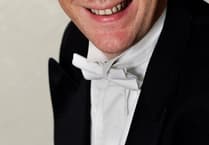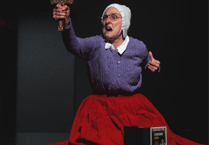I have attended concerts by the choir and orchestra of the Haslemere Musical Society for a number of years and I believe this amateur ensemble is steadily improving.
So it proved on March 1 at Haslemere Hall. Gone is the lack of confidence that existed in both choir and orchestra just a few seasons ago. Now they are giving their public exceptional musical evenings deserving of a capacity audience. They provided us with an evening of wonderful entertainment.
The evening began with a motet by Josef Haydn (1732-1809) entitled Insanae et Vanae Curae (Vain and raging cares) published in Haydn’s final year.
The choir were in confident voice backed by the orchestra, as usual, conducted by James Ross. This lively, short choral piece was superbly sung and the orchestra played with pinpoint accuracy. The motet was reworked from an oratorio 25 years earlier and is a very fine work, although not often performed these days.
This was followed by Antonin Dvořák’s (1841-1904) Symphony No. 5 in F major, in four movements. Composed in the summer of 1875, it is the first of his mature symphonies, leading to the great and very popular Symphony No. 9: From the New World.
This work was played with great enthusiasm, with punchy interludes from brass and percussion. It is not an easy piece as few of the themes are particularly memorable and they are not fully developed, but it was well played with superb orchestral blending. The cellos in the second movement gave a rich sonority to the opening theme, and the third movement’s beguiling melody rose from the orchestra with woodwind and horns prominent.
After the interval we were treated to the highlight of the evening, with a superb rendition of Max Bruch’s (1838-1920) Adagio on two Hebrew Melodies entitled Kol Nidrei.
A popular work for solo cello and orchestra, this was brilliantly played by Anna Hunt, the lead cellist of the ensemble. I have never heard this played better, it was absolutely superb. Its mournful, soulful melodies brought out by the rich sonority of Anna’s beautiful instrument were ably accompanied by the orchestra. This was an astounding performance which will live in my memory for a long time.
The final item of the evening was a magnificent performance by the soloists, choir and orchestra of Franz Schubert’s (1797-1828) Mass No. 2 in G.
The soloists were the very impressive soprano Clare Loosley, tenor Richard Thesiger-Pratt and bass Thomas Lydon. You can always tell when the singers and players enjoy performing a work, and it was obvious during this presentation. They were really giving it their all as they really loved this work.
After a rousing and confident start in the Kyrie, Clare Loosley’s strong, pure soprano broke through to captivate the audience. The dramatic Gloria, the gentle Credo, devotional Sanctus leading to the Benedictus and final Agnus Dei completed another delightful performance.
There is not much in this work for the tenor and bass soloists to display their talents in this mass, but the soprano made the best of her parts. The choir and orchestra certainly made us proud to have such musical talent in Haslemere during this performance.
A truly memorable evening was given by the members of the Haslemere Musical Society which was thoroughly enjoyed by a full house at Haslemere Hall.
Roger Saunders, president of the Recorded Music Society





Comments
This article has no comments yet. Be the first to leave a comment.